Introduction
It's been tempting lately to conclude that Apple doesn't have it anymore, and tablets in particular is where Cupertino does need to silence the prophets of doom and gloom after an iPad 4 that was more like a 3.1 and a mini that should've had a retina display.
To begin with, they could've done a lot worse than borrow a line from macbooks but the Air signature isn't just a PR stunt. It would be hard to believe it's the first time an iPad Air crossed anyone's mind as a cool name for a tablet but, by the looks of it, the iPad Air is very well the first that actually warrants it.
Just sounds right, doesn't it? And the iPad Air will definitely need all that crowd-pleaser ring when the fresh iPad mini with Retina display finally starts hitting the shelves. With Nexus tablets around, usual suspects Samsung, the new Surface, and now even Nokia on the list, an iPad has never arrived to such an unfriendly welcome. Yet, if Apple has done its job right, the Retina-flaunting mini will likely be the biggest threat.

Apple iPad Air
But let's not get ahead of ourselves and give the iPad Air a proper introduction. Easily one of the hottest pieces of hardware we've seen deserves it. Honestly, to say that a diet was all the iPad needed would be a massive understatement - after the iPad 4, which deservedly gets retired. But the way the iPad Air looks is a start made in heaven. The Air is almost 2mm thinner, and has unbelievably lost near a centimeter on each side - it's mostly screen bezel that's gone. The weight difference is the whopping 183 grams. The screen - the same gorgeous 9.7" canvas with 2048 x 1536px resolution.
Key features
- 9.7" LED-backlit IPS LCD touchscreen, 1536 x 2048 pixels, ~ 264 ppi; scratch-resistant, oleophobic coating
- Wi-Fi 802.11 a/b/g/n connectivity with MIMO dual antennas
- LTE connectivity (data only)
- GPS with A-GPS and GLONASS support (for the Cellular model only)
- Dual-core A7 64-bit 1.3 GHz Cyclone (ARM v8-based) chip with M7 motion coprocessor
- PowerVR G6430 quad-core GPU
- 1GB of RAM
- iOS 7.0.3 with iCloud support and activation
- 16/32/64/128GB of inbuilt storage
- Lighter at 469 grams (478 grams for the Cellular version)
- Thinner than ever at 7.5 mm
- Bluetooth 4.0
- Lightning USB port
- Stereo speakers
- Accelerometer, compass and three-axis gyro-sensor
- 5MP auto-focus camera
- 1080p video recording at 30fps
- 1.2MP 720p secondary camera capable of FaceTime HVGA calls
- Four and five-finger gestures
- Comes with premium set of free Apple apps - Pages, Garage Band, etc.
Main disadvantages
- Non expandable memory
- Price of storage climbs steeply, and storage is largely overpriced
- Tied into iTunes for uploading most of the content
- iOS 7 could've made better use of the bigger screen
- No standard USB port
- No GPS receiver in the Wi-Fi-only version
Along with the impressive loss of weight, the iPad Air has really stepped on the optimizations. There is a smaller battery powering the tablet but Apple promises the same 10 hours of battery life as before. The brains behind the tablet are the same as on the iPhone 5s - a class-leading 64-bit dual-core A7 chip that should be twice as fast as the predecessor's. The GPU is even a little more capable than on the iPhone, in keeping with the bigger display and higher resolution.
Apple took a big step in the right direction with this year's iPad lineup by equaling the mini and the Air's specs, so the only thing you need to choose is the screen size that works best for you. This puts the iPad Air in a sticky position, as the mini's handling and portability could be the big decider. The iPad Air, by the way, is now much more comfortable to hold and the narrower casing does wonders for single-handed operation but there's no avoiding the fact that the iPad mini is the friendlier form factor.
Last season's bigger iPad at least had the luxury of being more powerful but those days are gone.

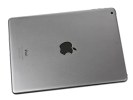
The Apple iPad Air at HQ
Yet, it might turn out in the end that it's the mini that has more to live up to - and prove that it truly is an equal in terms of performance. The iPad Air on the other hand seems off to a promising start. Let's see if it can really keep it up.
The usual accessories
The Apple iPad Air comes with a lightning cable and an A/C adapter - hardly a surprise after a few generations of tablets already. There are of course the usual leaflets and a couple of stickers.
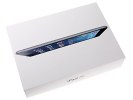
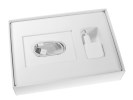
The iPad Air retail box
Apple gets plenty of repeat customers, meaning the most likely people to buy the iPad Air are ones that already have at least one iPad. But is it worth it? When the iPad 4 came out, there was very little sense for iPad 3 owners to update but this time it's different.
The iPad Air is a massive upgrade over the predecessors, not just in terms of its compact, light design, but a new, powerful chipset too and a new screen. Hopefully, the table below will give you the gist of iPad Air versus the outgoing iPad 4 and the iPad 2, which will stick around for another while.
Apple iPad Air
|
Apple iPad 4
|
Apple iPad 2
| |
Display
|
9.7" IPS LCD
|
9.7" IPS LCD
|
9.7" IPS LCD
|
Resolution
|
2048 x 1536
(264 ppi) |
2048 x 1536
(264 ppi) |
1024 x 768
(132 ppi) |
Height
Width Thickness |
240 mm
169.5 mm 7.5 mm |
241.2 mm
185.7 mm 9.4 mm |
241.2mm
185.7mm 8.8mm |
Weight
|
469 g (Wi-Fi)
478 g (Wi-Fi + Cellular) |
652 g (Wi-Fi)
662 g (Wi-Fi + Cellular) |
601 g (Wi-Fi)
607 g (Wi-Fi + Cellular) |
OS
|
iOS 7
|
iOS 7
|
iOS 7
|
Siri
|
Yes
|
Yes
|
No
|
Processor
|
Apple A7 chipset
dual-core 1.3 GHz Cyclone cores (64-bit, ARM v8-based) |
Apple A6X chipset
dual-core 1.4GHz Swift cores (32-bit, ARM v7-based) |
Apple A5 chipset
dual-core 1GHz Cortex-A9 cores (32-bit, ARM v7-based) |
GPU
|
PowerVR G6430
|
PowerVR SGX554MP4
|
PowerVR SGX553MP2
|
RAM
|
1GB
|
1GB
|
512MB
|
Storage
|
16GB / 32GB / 64GB / 128 GB
|
16GB / 32GB / 64GB / 128 GB
|
16GB / 32GB / 64GB
(only 16GB still on sale) |
microSD card slot
|
No
|
No
|
No
|
Primary camera
|
5 MP, 2592 x 1944 pixels,
BSI sensor, autofocus, LED flash, 1080p@30fps, HDR, video stabilization touch focus, face detection |
5 MP, 2592 x 1944 pixels,
BSI sensor, autofocus, LED flash, 1080p@30fps, HDR, video stabilization touch focus, face detection |
0.7MP Fixed-Focus
720p video |
Front camera
|
1.2MP
720p@30fps |
1.2MP
720p@30fps |
0.3MP VGA
|
Battery
|
8,820 mAh
|
11,560 mAh
|
6,930mAh
|
Wi-Fi
|
Wi-Fi 802.11 a/b/g/n, MIMO, dual-band, Wi-Fi hotspot, AirPlay
|
Wi-Fi 802.11 a/b/g/n, dual-band, Wi-Fi hotspot, AirPlay
|
802.11 a/b/g/n
|
Bluetooth
|
Yes, v4.0 with A2DP
|
Yes, v4.0 with A2DP
|
Yes, 2.1 + EDR
|
Network
|
Quad-band GSM/GPRS/EDGE
Quad-band UMTS/HSPA LTE support, fourteen bands |
Quad-band GSM/GPRS/EDGE
Penta-band UMTS/HSPA LTE support, five bands |
Quad-band GSM/GPRS/EDGE
Penta-band UMTS/HSDPA/HSUPA |
SIM slot
|
Nano-SIM
|
Micro-SIM
|
Micro-SIM
|
Speakers
|
Stereo
|
Mono
|
Mono
|
Port
|
Lightning, USB 2.0
|
Lightning, USB 2.0
|
30-pin connector, USB 2.0
|
Distinctive features
|
Thin iPad mini-like body, light
|
More powerful than iPad 2
|
Thin and light, cheaper
|
Available
|
Yes
|
Discontinued
|
Yes
|
Base price
|
$500
|
-
|
$400
|
Fit and fine
Taking heavily after the original iPad mini, the iPad Air moves away from the sloping edges of old, resulting in a more muscular, and somewhat more compact feel, reinforced by the much thinner frame. The bezels around the screen have been significantly narrowed, which - convincingly - creates an impression of a much more immersive screen.
To run by the numbers, the iPad Air is a whopping 16.2mm narrower than its predecessor, 1.9mm thinner and 1.2mm shorter. The weight is probably the most radical of changes - having lost the unbelievable 183g, the new iPad Air takes a huge load off your hands.
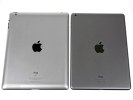
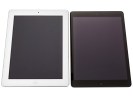
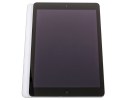
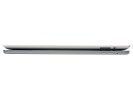
iPad Air next to predecessor
The question still remains of how the Air will co-exist with the new iPad mini with Retina display, which simply is a downscaled replica. In terms of what rival platforms have to offer though, the iPad Air may actually enjoy a certain level of comfort and safety knowing it's the most compact big tablet in the market. On the other hand, the competition has mostly caught up and even edged forward in terms of screen resolution.
Controls and handling
The iPad Air may premiere a new design (in the size-L category at least) but hasn't changed much in terms of controls. The front has the same 9.7" 1536 x 2048 IPS LCD of 264 ppi. Above it we find the same 1.2 MP resolution front-facing camera capable of 720p video capture. There's also an ambient light sensor.
Under the screen lies the familiar home button. Many must've been hoping for a Touch ID scanner on the iPad Air but to no avail. Perhaps next year?
Anyway, the home button seems to have a more solid click compared to our iPhone 5s but it could also just be a unit-specific quirk.
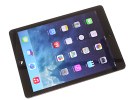
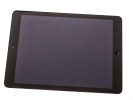
iPad Air up front
The left side is completely bereft of controls, while on the right we find the silencer switch (that will also lock screen orientation) and the two volume keys. They have solid feedback and are generally very comfortable, the only problem is getting to them in either portrait and landscape as they are very far off your fingers.
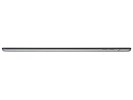
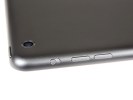

The sides of the tablet
For the first time on a full-grown iPad we find stereo speakers. These are hardly unforeseen since we saw those first on the original iPad mini, but the pleasant surprise is they are impressively loud. In fact the whole slate vibrates when they're pumping out sound.
There's the now typical Lightning connector port at the bottom. The top is reserved for the 3.5 mm headphone jack and one of the two microphones. The audio jack placement is a little inconsistent - the iPhone has its on the bottom and it would make much more sense to have it there on the iPad too to not have cables running over the screen when you've attached a set of headphones.


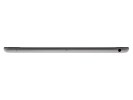
The top and bottom
The second microphone is on the back along with an Apple logo with a mirror finish. In the top left corner sits a 5 MP iSight camera, which hasn't seen any technical upgrades besides a reportedly improved backside sensor illumination. Aperture is still set at f/2.4 and the camera still lacks an LED flash.
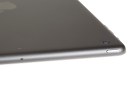
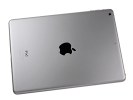

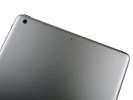
On the back
While immense progress has been made by Apple to reduce the burden of handling an iPad Air, the tablet is still on the big side perhaps for single-handed operation. However, when held with both hands the device fits nice and comfortable and the bezels are just enough on both sides for your thumbs to rest without getting into the screen.
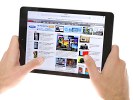
Handling the iPad Air
We love thin bezel designs as they put the screen more into focus but what makes the iPad Air a better tablet than its predecessors is the huge weight difference. Being 183g lighter, the iPad Air is easier to handle for prolonged periods of time without making your hands numb.
It still not the lightest of loads to keep standing in your hands but, compared to other big tablets like the current Nexus 10 or the Galaxy Note 10.1 2014, the iPad Air really does live up to its name.
Well-known premium screen
Apple introduced the Retina display back in 2012 on the third-generation iPad and hasn't increased the resolution since. The competition has meanwhile caught up, with Samsung-made droids inching forward with tablet displays of 2560 x 1600 probing 300 ppi.
However, you're likely to look at the iPad Air's screen from an arm's length where things look as crisp as possible, even compared side by side with a Galaxy Note 10.1 2014. Looking at the screen from really up close doesn't reveal the pixels and things tend to be nicely sharp and readable - even small fonts on web pages.


The 9.7" display
The pixel arrangement is the same as before (read iPad 3 and 4) - you get a standard red, green and blue pixel side by side.
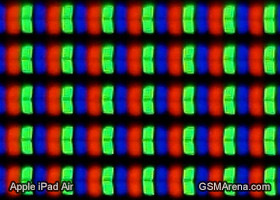
Looking at the numbers the iPad Air stacks pretty well against the competition. The ASUS Transformer Pad TF701T, which we recently reviewed, seems like the only tablet that beats the iPad Air hands down, while the Sony Xperia Tablet Z has a slight edge. Otherwise we'd easily deem the iPad Air's 9.7" screen one of the best on the market.
| Display test | 50% brightness | 100% brightness | ||||
| Black, cd/m2 | White, cd/m2 | Black, cd/m2 | White, cd/m2 | |||
| Apple iPad Air | 0.19 | 181 | 968 | 0.53 | 508 | 964 |
| ASUS Transformer Pad TF701T | 0.40 | 450 | 1125 | 0.71 | 755 | 1119 |
| Samsung Galaxy Note 10.1 2014 | 0.27 | 221 | 831 | 0.53 | 440 | 821 |
| Google Nexus 10 | 0.26 | 223 | 859 | 0.50 | 443 | 878 |
| Sony Xperia Tablet Z | - | - | - | 0.53 | 531 | 996 |
| Sony Xperia Tablet S | 0.35 | 334 | 947 | 0.67 | 526 | 783 |
| Samsung Galaxy Note 3 | 0 | 149 | ∞ | 0 | 379 | ∞ |
| Apple iPad mini | 0.25 | 208 | 838 | 0.51 | 458 | 812 |
| Apple iPad 3 | 0.21 | 167 | 809 | 0.6 | 477 | 779 |
| Apple iPad 4 | 0.21 | 163 | 797 | 0.63 | 476 | 762 |
| Samsung Galaxy Tab 7.7 | 0 | 200 | ∞ | 0 | 328 | ∞ |
| Asus Google Nexus 7 | 0.25 | 244 | 954 | 0.36 | 327 | 908 |
| Samsung Galaxy Note 10.1 | 0.27 | 223 | 832 | 0.49 | 406 | 821 |
| Samsung Galaxy Tab 10.1 | 0.31 | 257 | 826 | 0.55 | 502 | 915 |
| Samsung Galaxy Tab 7.0 Plus | 0.17 | 196 | 1141 | 0.34 | 424 | 1236 |
Battery life
The iPad Air has to make do with a smaller battery than the 11560mAh behemoth found in the iPad 4 but Apple still claims 10 hours of web browsing. The new battery is a 32.4Wh unit compared to the 42.5Wh of the predecessor.
The Apple iPad Air did more than enough to live up to Apple's claims and then some. The slate managed a 10:20 hour run in our browsing test and 12:49 hours of video playback. It didn't quite beat ASUS' Transformer Pad TF701T we recently reviewed.
